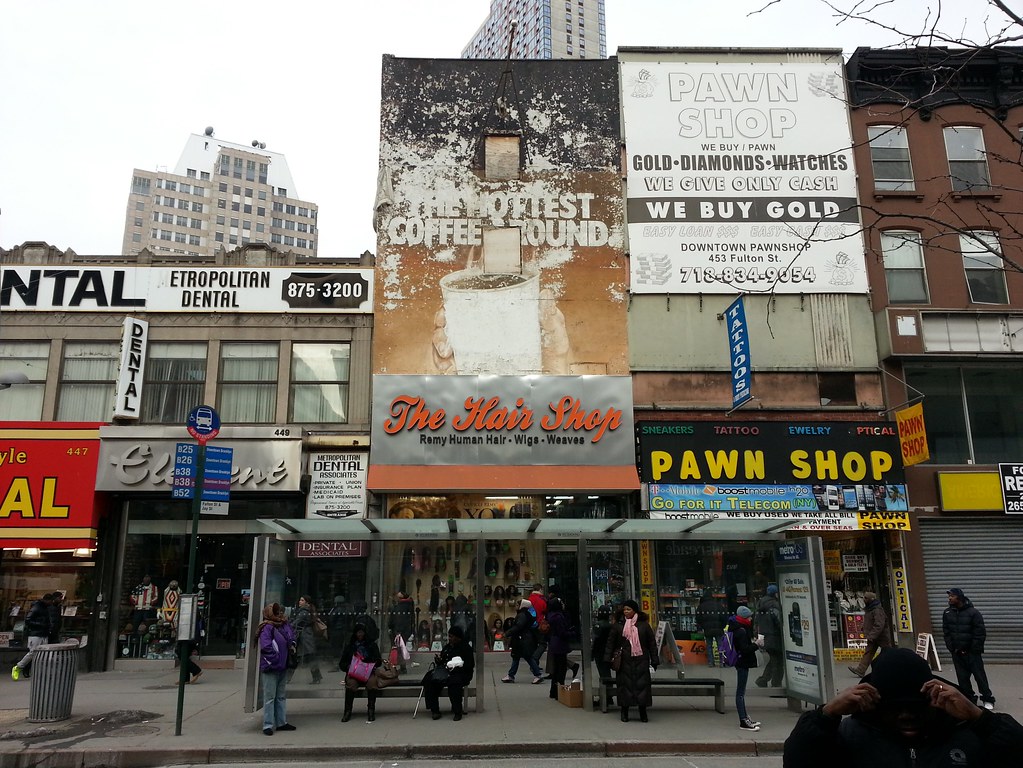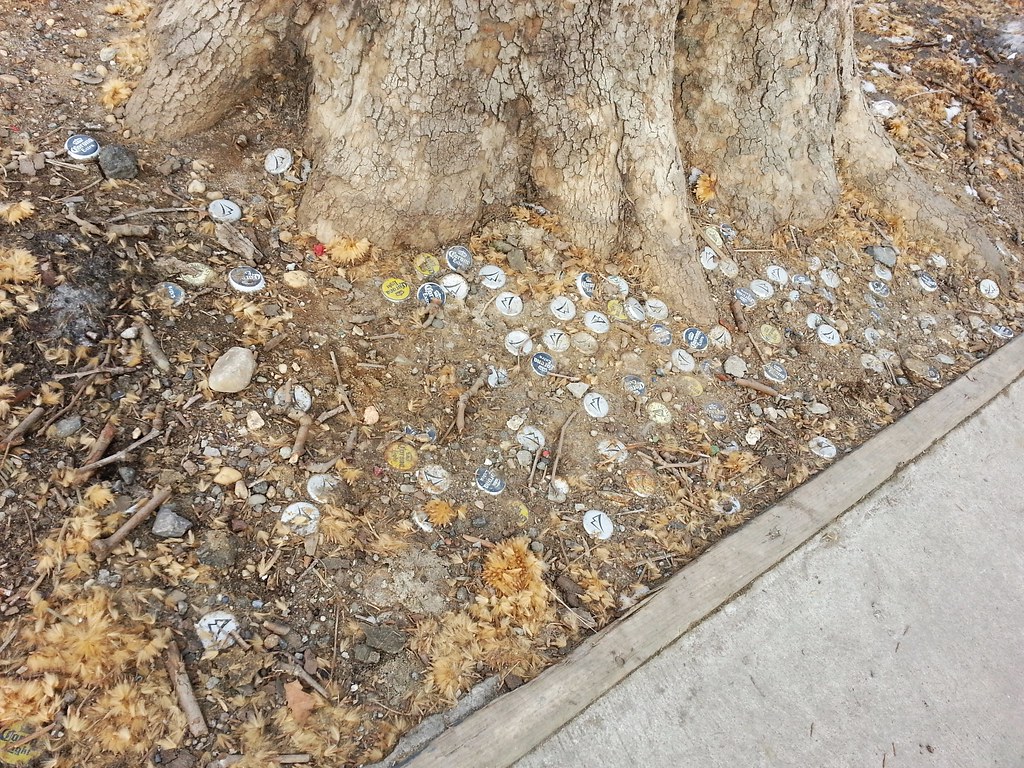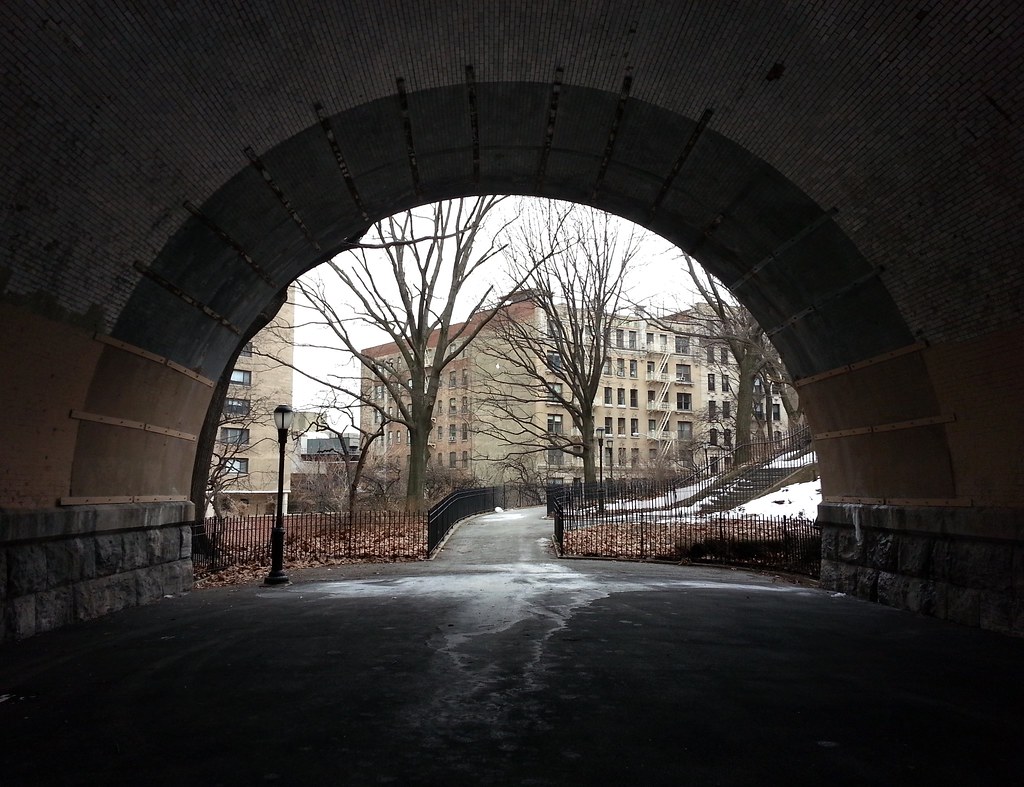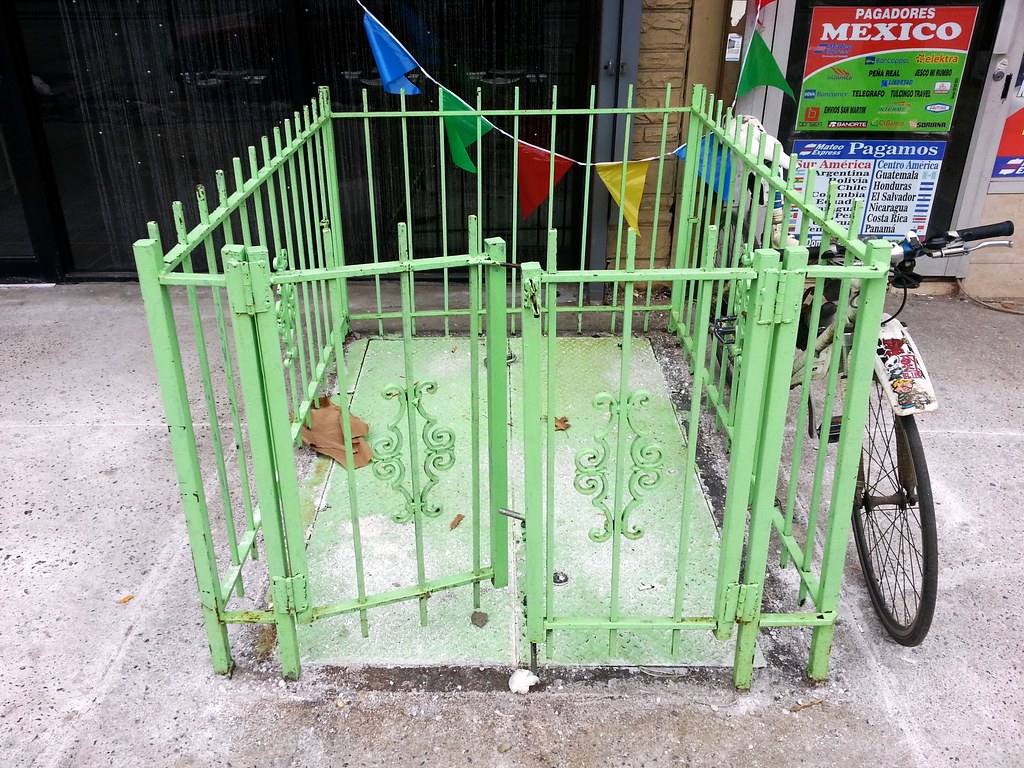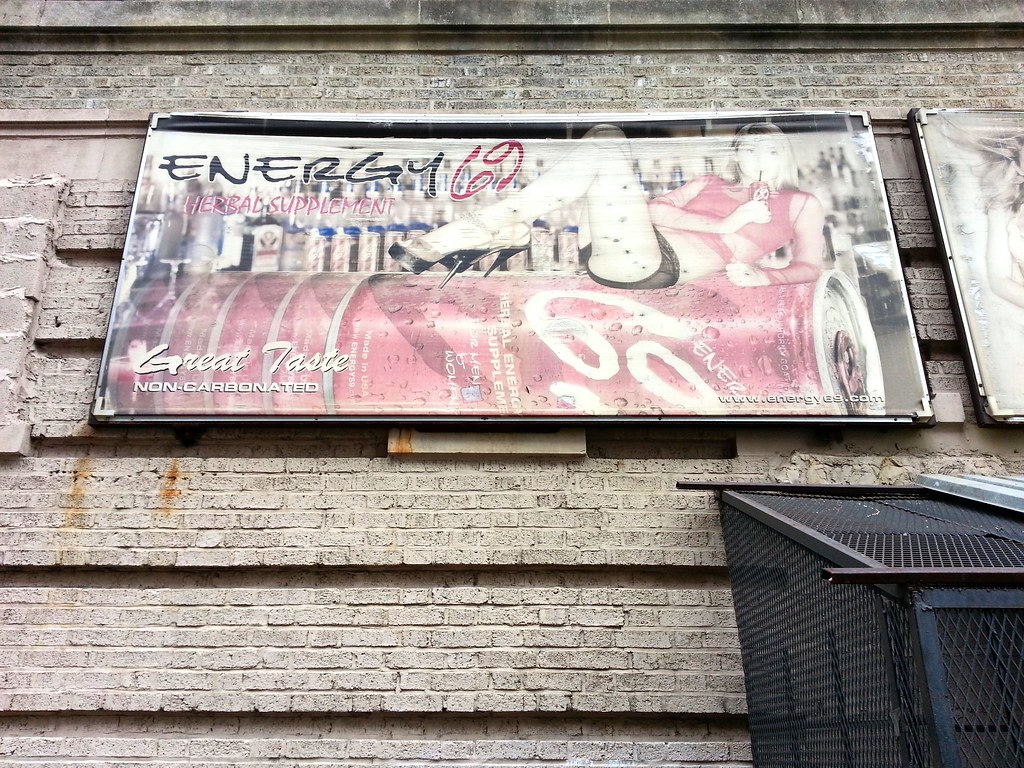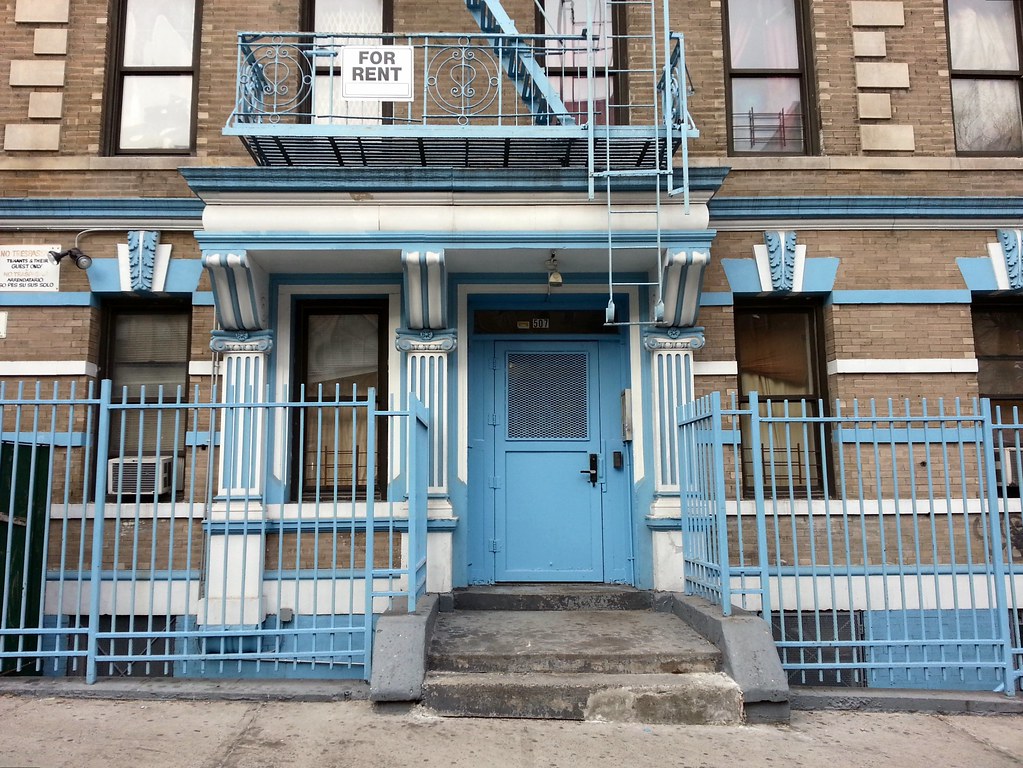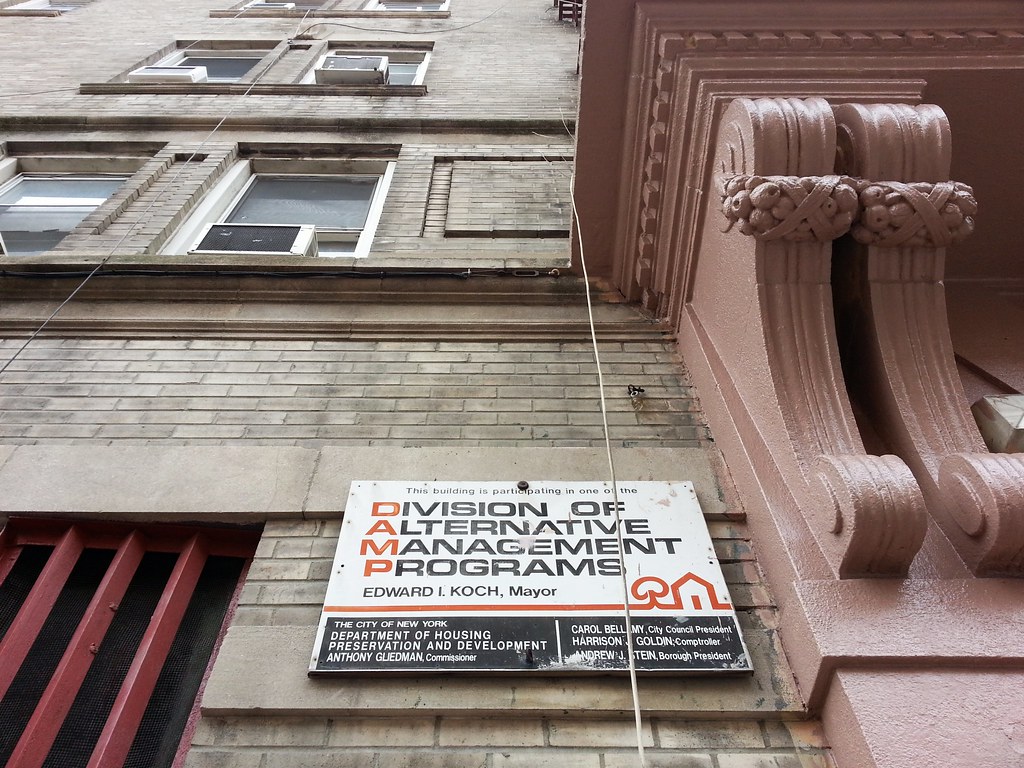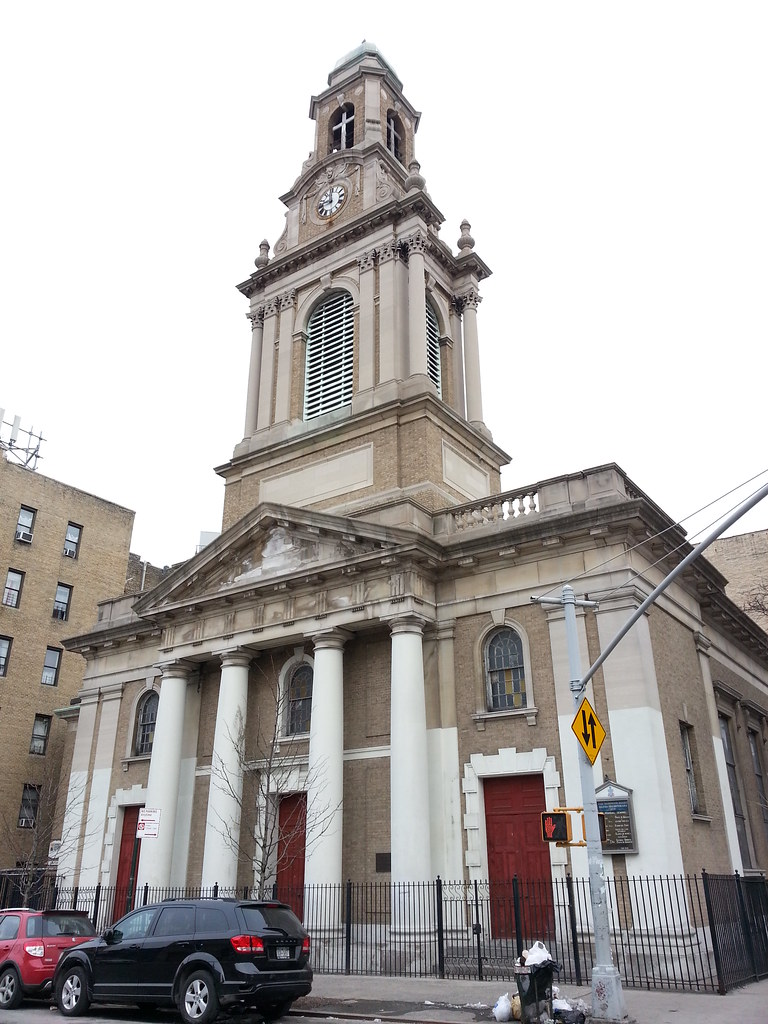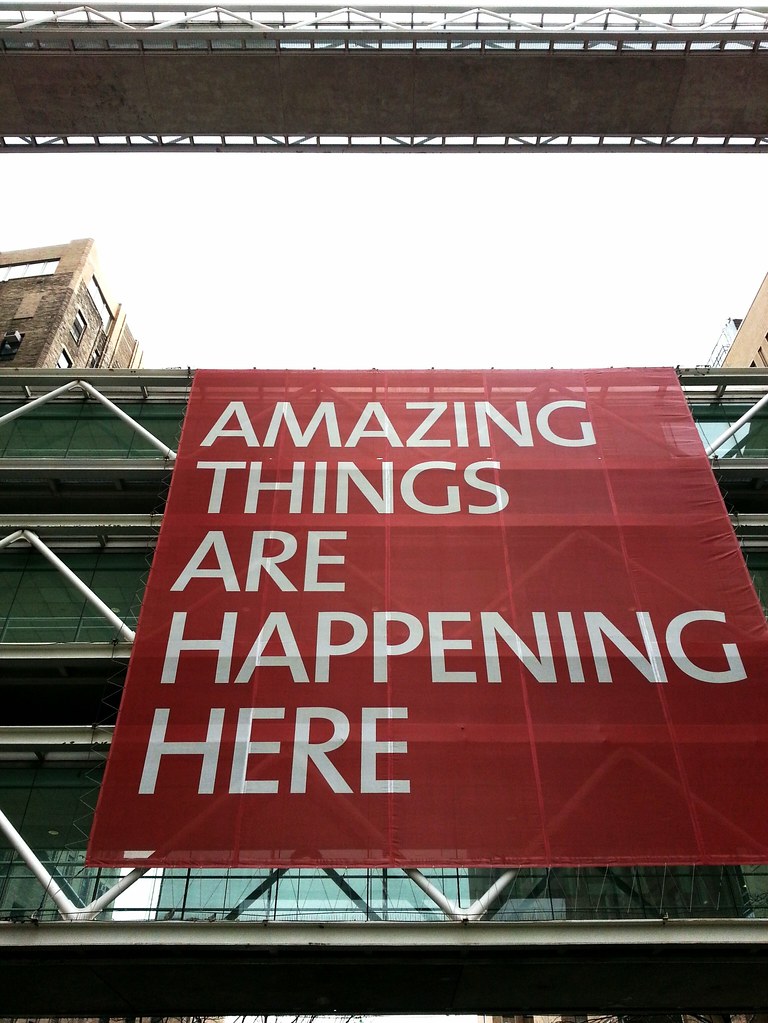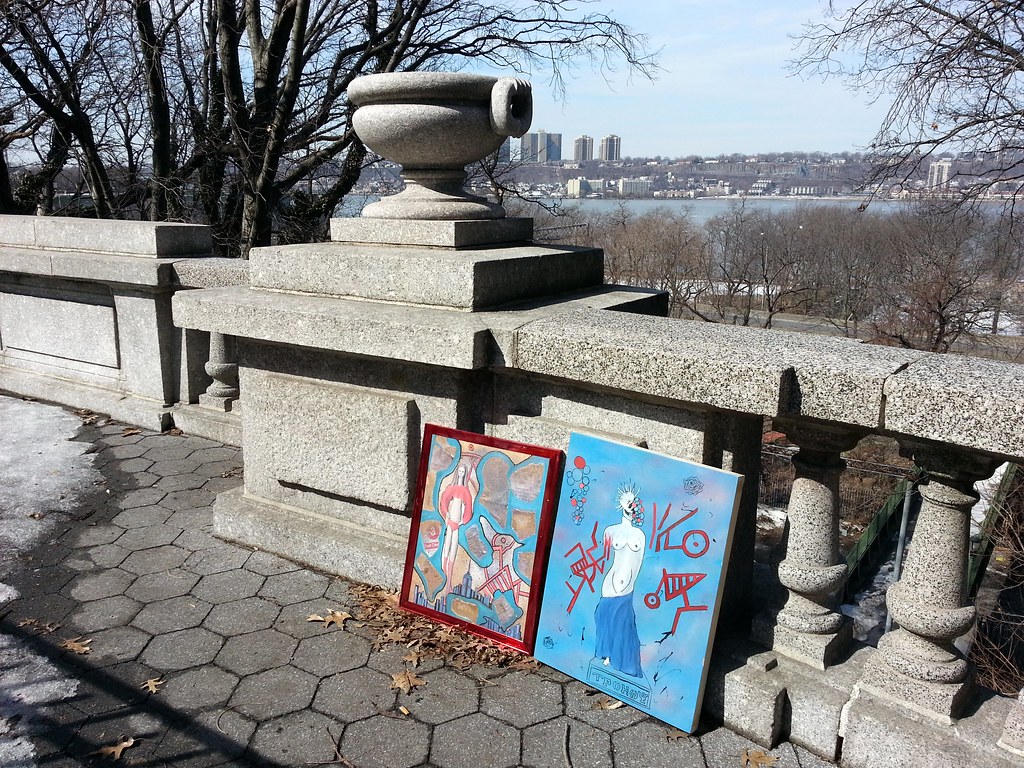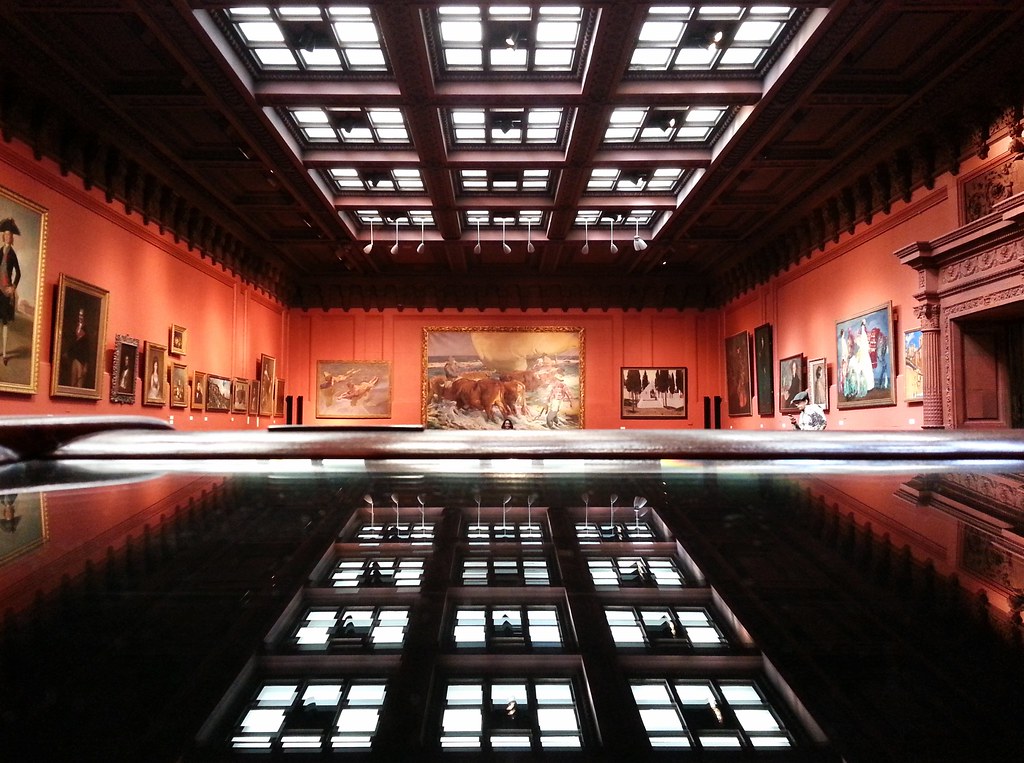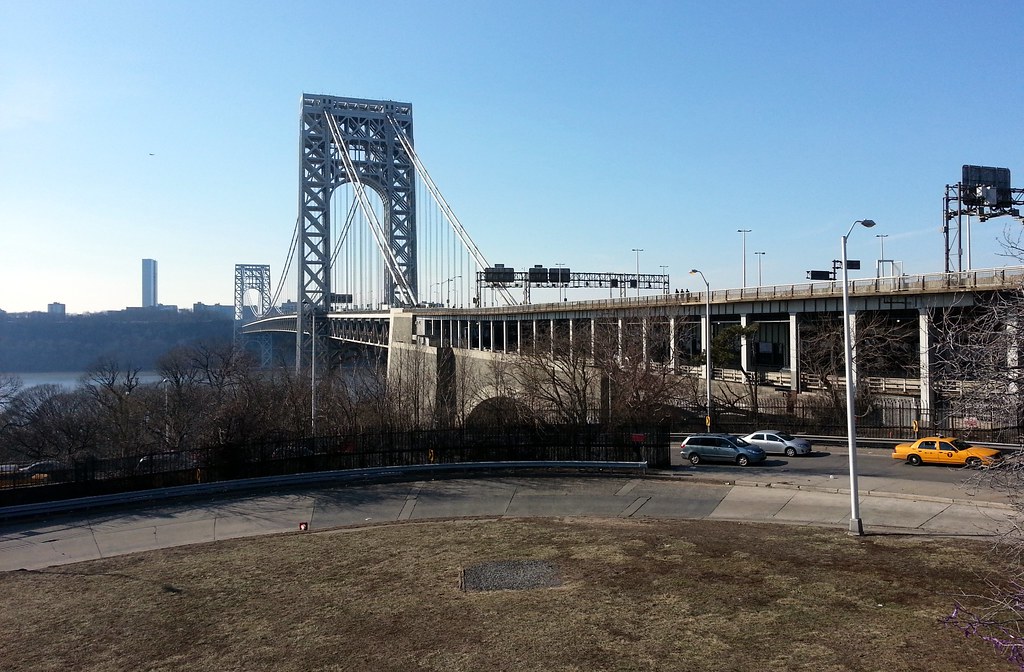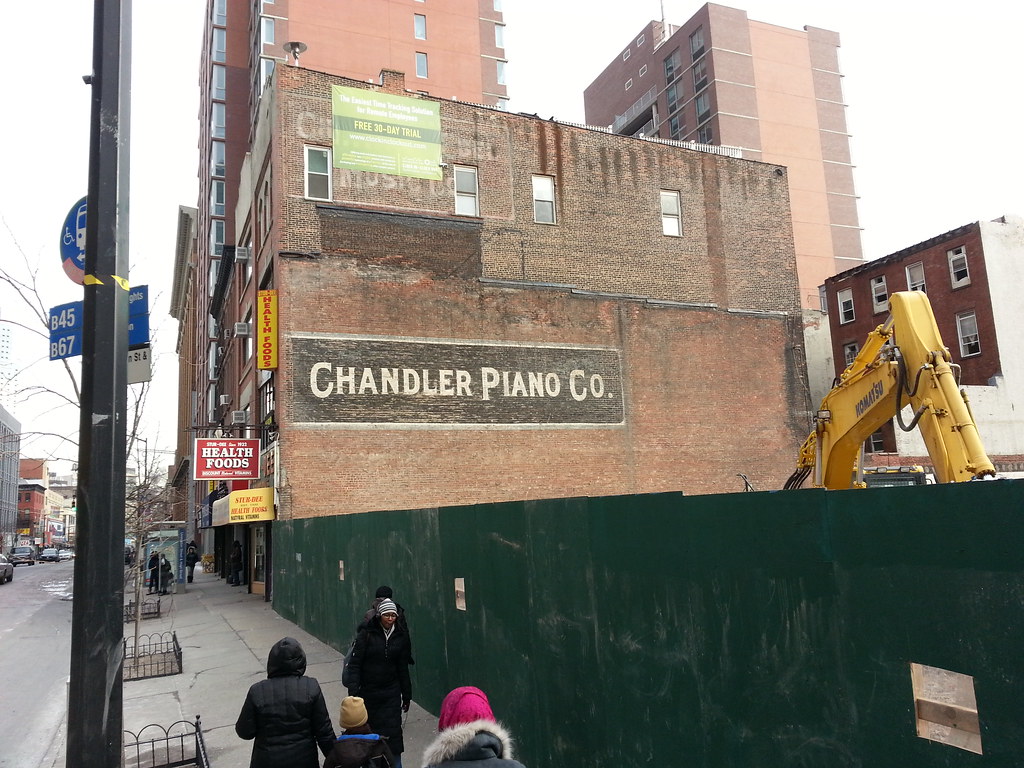
This painted sign was recently uncovered when the building next door was demolished. Chandler, whose featured line of pianos was Ivers & Pond, was founded in 1869, and was said to be Brooklyn's oldest piano house when it moved from this location in 1928.

These kitty condos, two of the dozen or so I saw today at the northern end of Morningside Park (there's a third one partially visible higher up on the rocks), provide shelter for the park's sizable feral cat population. They read: "NYC Animal Research Do Not Remove". I called the phone number written on the boxes; the guy who answered told me they're spaying and neutering the cats, trying to find homes for the friendly ones, and putting out these little huts so the wild ones can stay warm through the winter.

West 130th Street between 12th Avenue and Broadway is only the second section of road I've encountered that's been closed not just to cars but also to pedestrians. (The first was East 146th Street/Canal Place in the Bronx.) I'll have to come back and walk it once it reopens, although it's not clear when that will happen. It's already past the date on the sign, and, as you'll see, the street is nowhere close to being open, or even to being recognizable as a street...
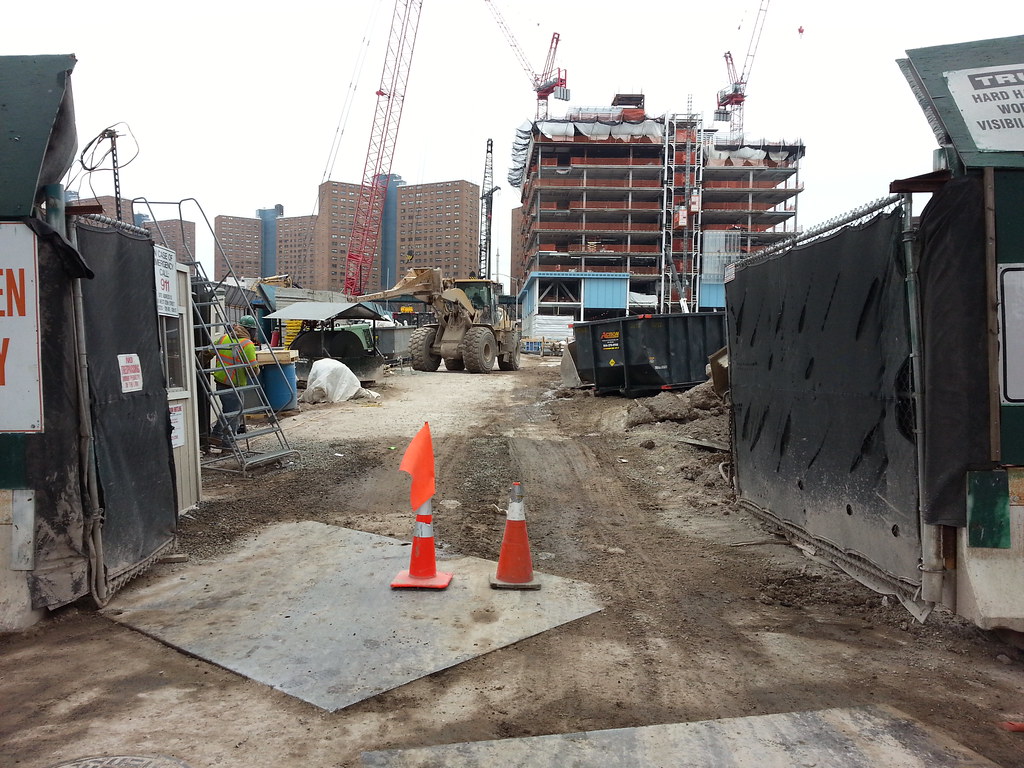
This road closure and reconstruction is part of Columbia University's massive and controversial expansion into Manhattanville. The building rising in the back, the first structure to take shape on the new campus, is the Jerome L. Greene Science Center.
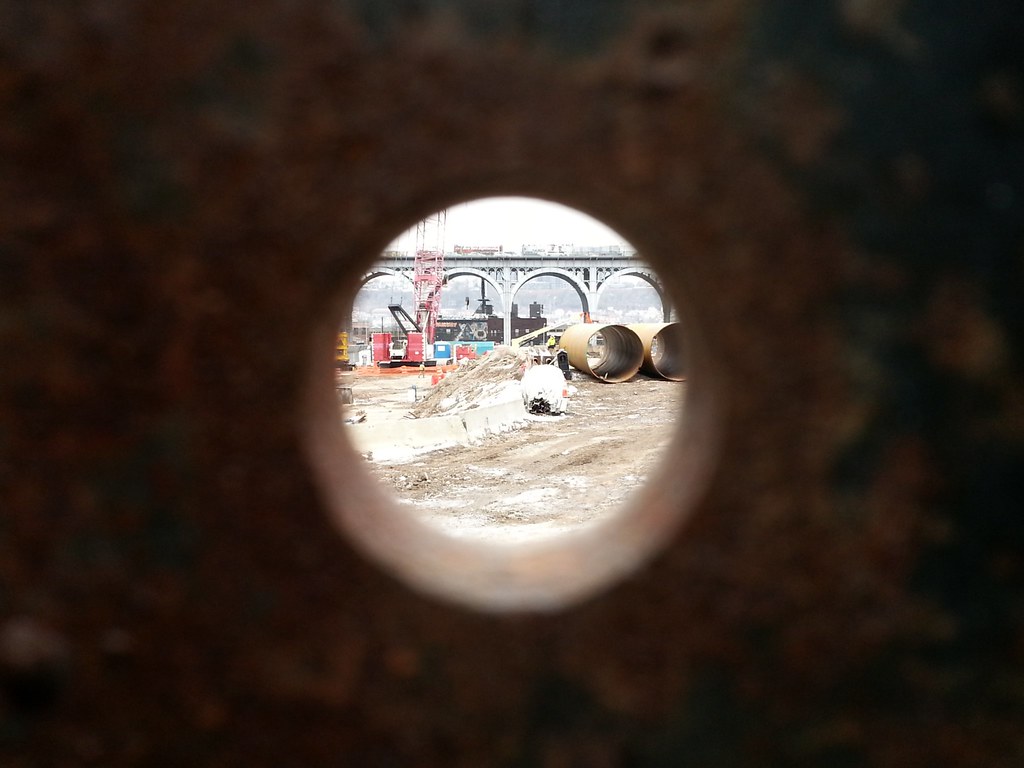
Peering west across Columbia's construction site toward the Riverside Drive viaduct
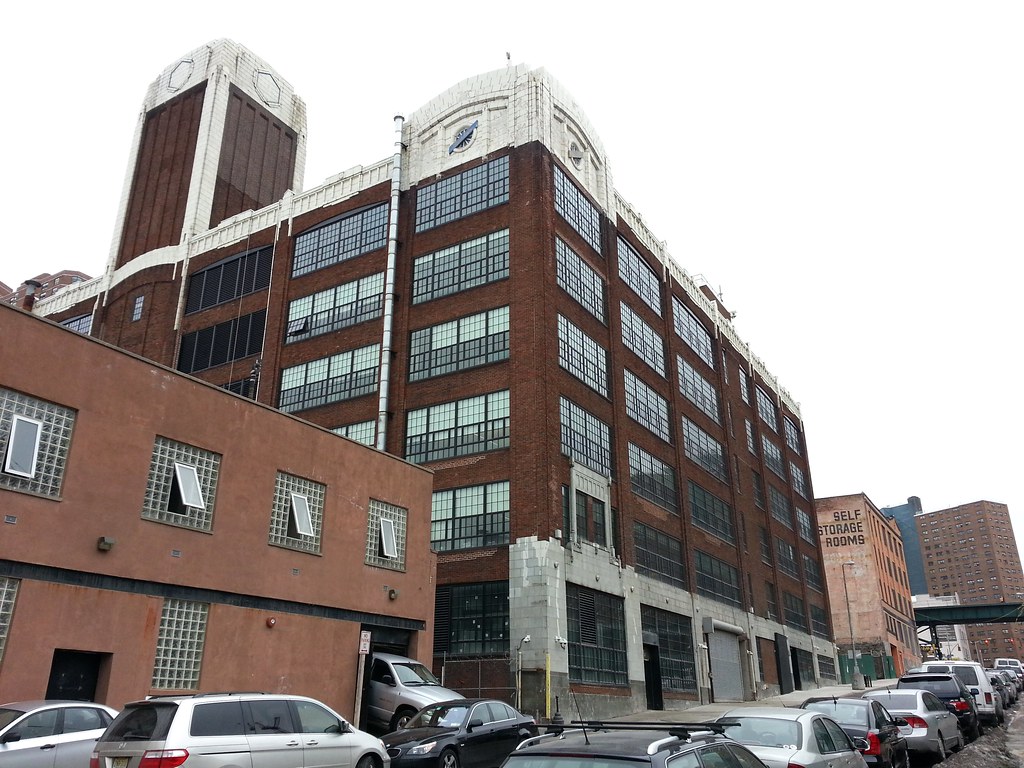
Erected around 1923 as a finishing facility for newly manufactured Studebakers, this building has subsequently served as a milk processing plant and has housed, among other things, a doll factory and part of the American Museum of Natural History's Polynesian antiquities collection. Columbia University has rented space here for over two decades and now plans to incorporate the building into its new Manhattanville campus, making it one of only a few existing buildings within the bounds of the future campus that will still be standing when construction is complete in two decades or so.

Owned by Columbia University since 1949, this 1911 building was originally a milk processing plant operated by Sheffield Farms (whose "Class I gravity milk plant" — one of only two in the country when it opened in 1914 — we saw in the Bronx). Sheffield was later joined in the neighborhood by Borden, which converted the nearby Studebaker building into a milk plant in 1937.
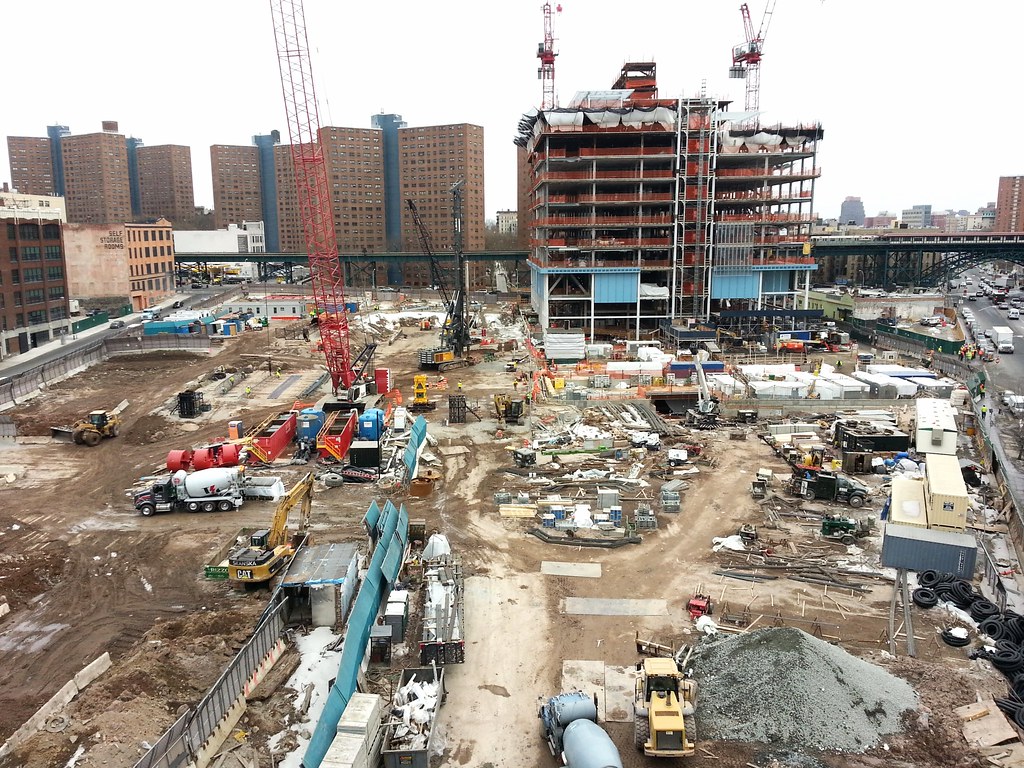
of part of Columbia University's future campus in Manhattanville. Standing atop the Riverside Drive viaduct, we're looking east at the skeleton of the new Jerome L. Greene Science Center, with the elevated 1 train crossing 125th Street in the background at right. 130th Street used to run right down the middle of this scene, and eventually will once again.
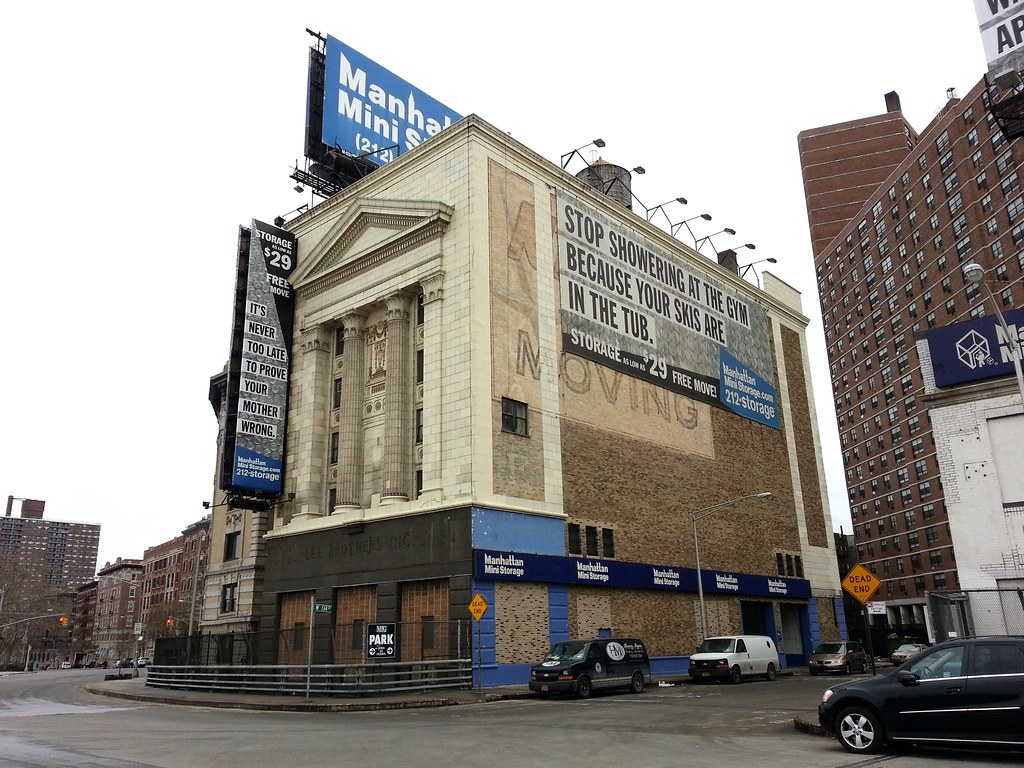
Currently used for self-storage, this classically styled edifice was built in the late 1920s as a "furniture warehouse", according to a 1998 NY Times article. "The columns and pilasters mask a cavernous interior, containing over 1,000 storage rooms and vaults, built of thick concrete and steel and dispersed over 14 floors. Roughly half the floors are built below street level, far below the [Riverside Drive] viaduct" (on which I'm standing). This view from down below on the Henry Hudson Parkway makes the actual size of the building a little clearer.
The architect was George S. Kingsley, who "designed several other historically inspired storage warehouses", including the similar Atlas Storage building in Philadelphia and the Egyptian Revival Reebie Storage Warehouse in Chicago. Even given the different architectural standards of that era, it seems kind of odd that such refined designs were employed for these utilitarian structures. The reason for this, I think, is obscured by the vague descriptions of these facilities as "furniture warehouses" or "storage warehouses". What does that mean exactly?
We start to get a better sense when we find out that Mr. Kingsley's architectural specialty was "secure storage for shorebound summer vacationers". And a while back, when passing by the Portovaults of Day & Meyer, Murray & Young, we learned that the well-to-do once "stored seasonally . . . When people went away for the summer, they rolled up their rugs and took their silver and put it in storage." So I'd imagine that the clientele of these former businesses was considerably wealthier than the budget-conscious customers of today's self-storage warehouses. Perhaps the grand, imposing architecture was important for appealing to that snootier demographic.
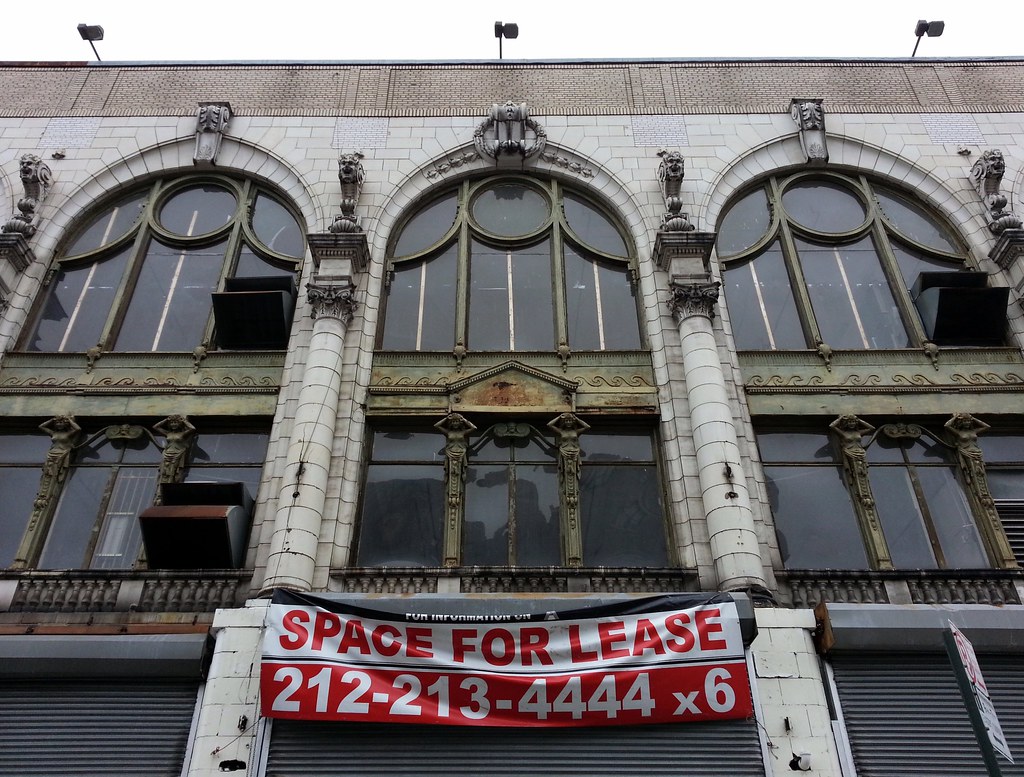
This building, featuring one of renowned theater architect Thomas Lamb's "most ebullient facades", originally contained the lobby of the 1913 Hamilton Theater. In recent years, it has served as the home of at least two discount retail stores; one of them, Hamilton Palace, was described by a Yelp reviewer as "Target after the apocalypse."
The former theater's 2,500-seat auditorium, located just behind this building, has been unused and decaying for some time. Here's a great photo tour of what the NY Times's Christopher Gray called "one of the most spectacular wrecks in New York City."
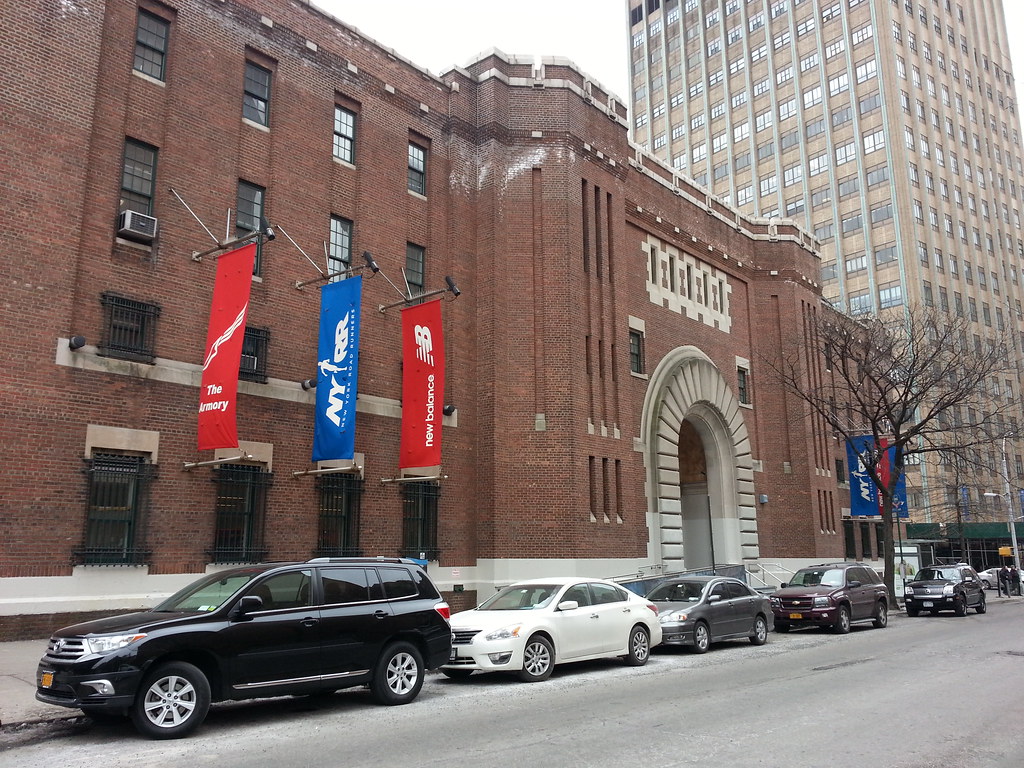
Built to house the 22nd Regiment of the Army Corps of Engineers, this armory was completed in 1911, and began hosting track meets shortly thereafter. By the middle of the 20th century, it had become "the cathedral of indoor high school track in the region", with an aging wooden running surface infamous for the generously sized splinters it would embed in the legs of any racer unfortunate enough to trip and fall during competition. (Here are one runner's recollections of those days.)
In the mid-1980s, the city decided to close the track and turn the armory into a vast homeless shelter that at times held up to 1,200 men. The place became notorious for its violence, drugs, and squalor, and was shut down several years later. The track reopened in 1993, this time boasting a new Olympic-style synthetic surface, and has once again become a "runners' mecca". The armory's stature in the world of athletics was given another boost in 2004, when it was dedicated as the new home of the National Track and Field Hall of Fame.
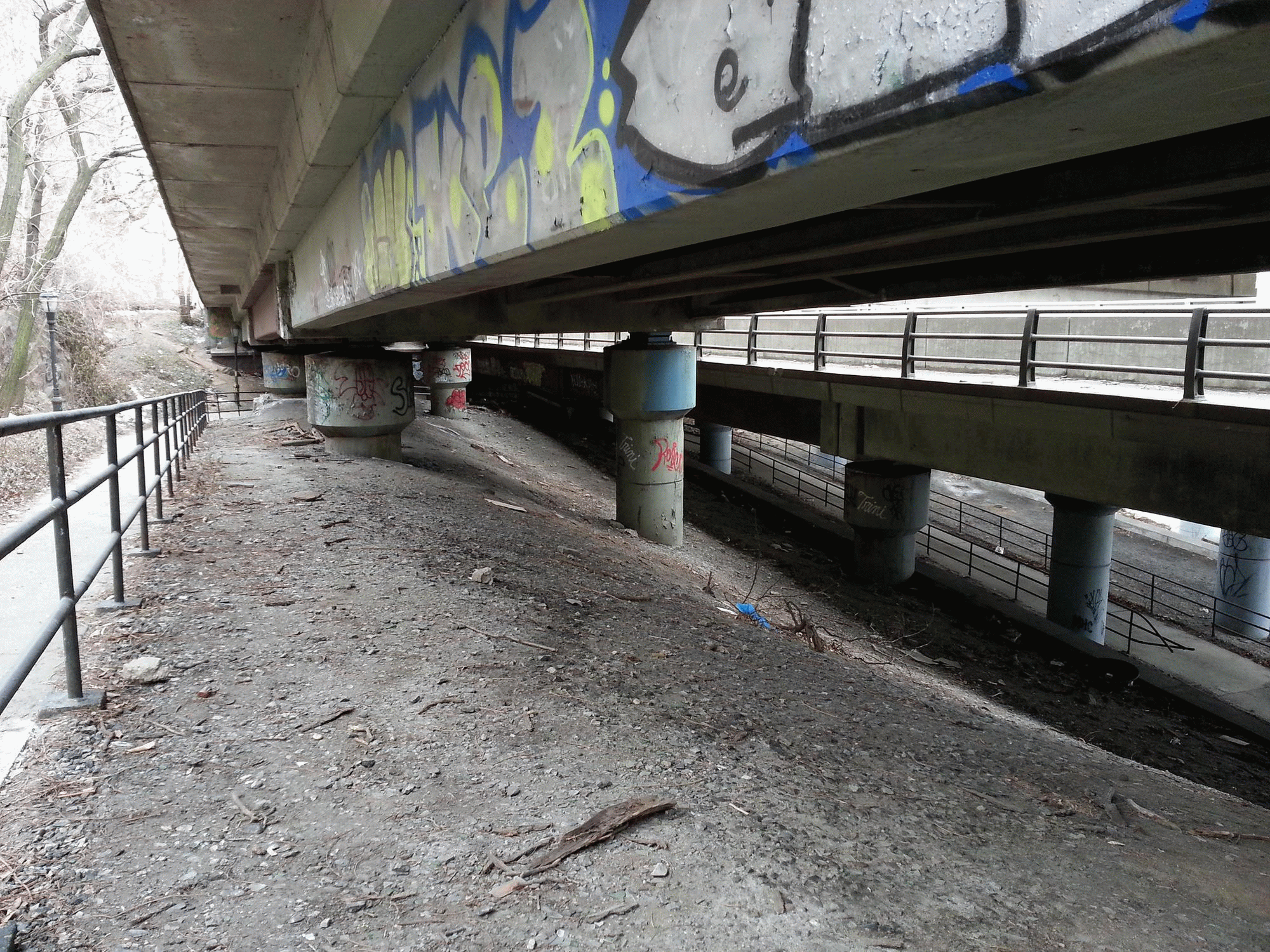
beneath the tangle of ramps leading to and from the George Washington Bridge
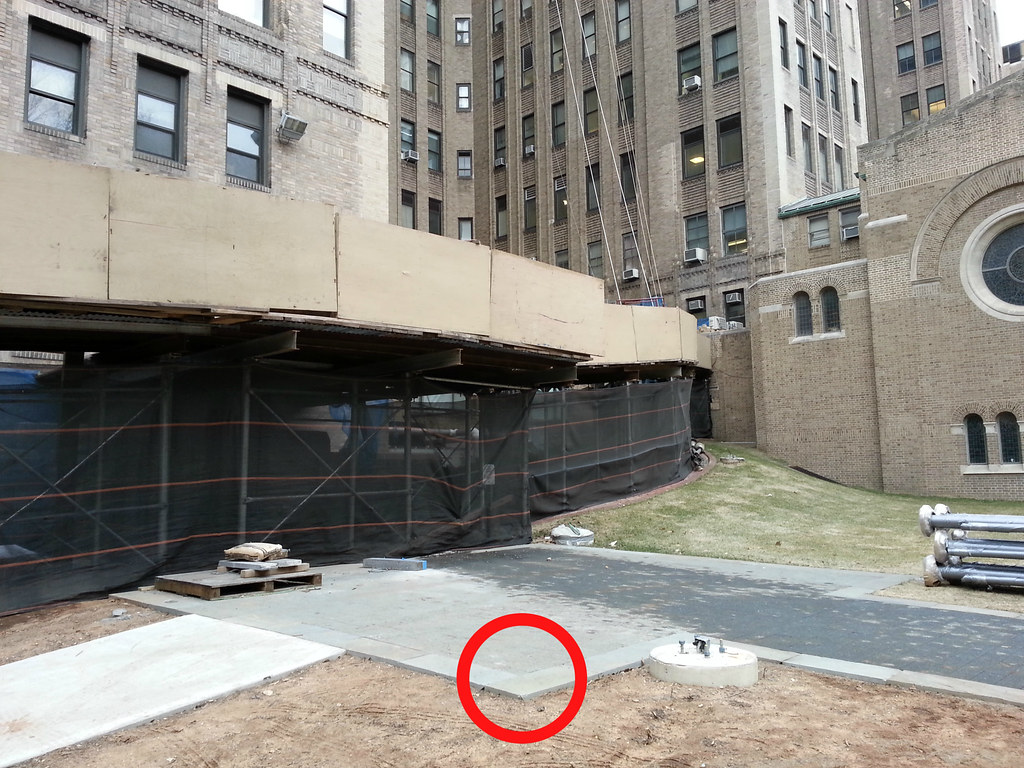
Until it was removed during the ongoing construction here at NewYork-Presbyterian/Columbia University Medical Center, a plaque could be found on the ground at about the spot I've circled in red. It marked the former location of home plate at Hilltop Park, where the New York Highlanders (a.k.a the New York Yankees) played from 1903 to 1912. We're looking straight out into center field in this photo; using the diagonal left edge of the concrete to approximate the base line, we can roughly estimate the location of third base (now somewhere inside the building at left), where a stealing Ty Cobb slid into Jimmy Austin in one of baseball's most famous photographs. (Here's the story behind that image, "the greatest action picture ever made on the ball field".)
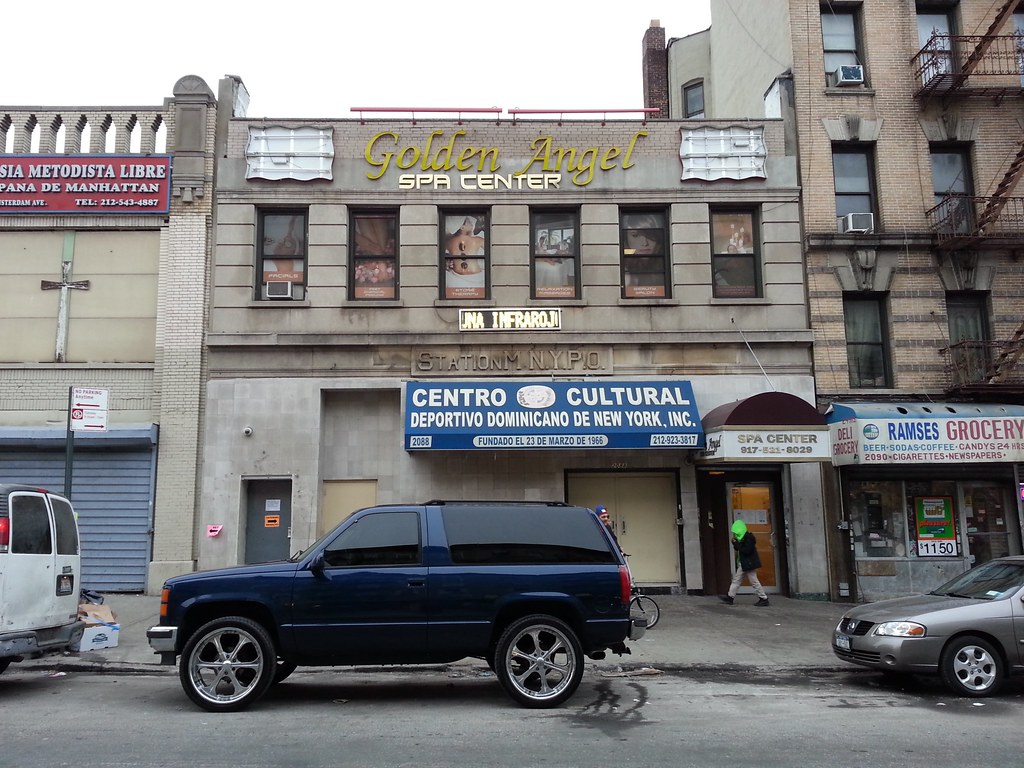
While this building was not its original home, Station M existed at least as far back as 1863, when it was one of 14 post offices on the island of Manhattan: the main office plus Stations A through N, excluding I. Half a century later, a carrier from this station unwittingly delivered a package bomb to a local man. The NY Times report on the incident featured the following headline and sub-headlines:
BOMB BIG ENOUGH TO WRECK BUILDINGAn article in The Sun said the police suspected the sender of the bomb was a man in Connecticut who "may have been jealous of Franck's attentions to a young woman in New Britain".
-----------------------------
Jacques Franck of 709 West 170th Street Gets a Box of "Socks."
-----------------------------
DENIES HAVING ENEMIES
After Mr. Franck discovered that his package contained a bomb, and not the "fine socks" he was expecting, the excellently named Bureau of Combustibles was called in to investigate. According to a 1907 NY Times piece with the sub-headline "How the City Disposes of Bombs and Explosives—Ticklish Work for the Bureau of Combustibles":
Few . . . realize the extent of bomb-making and the illegal traffic in explosives in a city like New York. At least 200 bombs and infernal machines are found here by the police every year . . . They are, of course, the bombs and infernal machines which do not explode. The total does not take into account crimes of the sort that are successful. Other explosives are seized by the city authorities in sufficient quantities to warrant special provisions being made for their storage and destruction. In the yard back of the headquarters of the Fire Department, in Sixty-seventh Street, near Third Avenue, there is a small building covered with sheet iron and bearing a sign which reads: "Magazine—Danger!" Behind the padlocked doors is a collection of contraband explosives that would amaze the majority of New Yorkers.
When a bomb or infernal machine is found by the police it is turned over to the Bureau of Combustibles of the Fire Department. The hazardous task falls to the bureau employees of investigating the dangerous package. . . .
The question naturally arises: What becomes of the contraband explosives? A favorite method of getting rid of them is to gather them periodically, place them on one of the municipal boats, and have them dumped into one of the rivers. The spot for depositing them is usually the "Black Hole" at Hell Gate. There the rocks and swift current soon make them harmless, even for fishes.
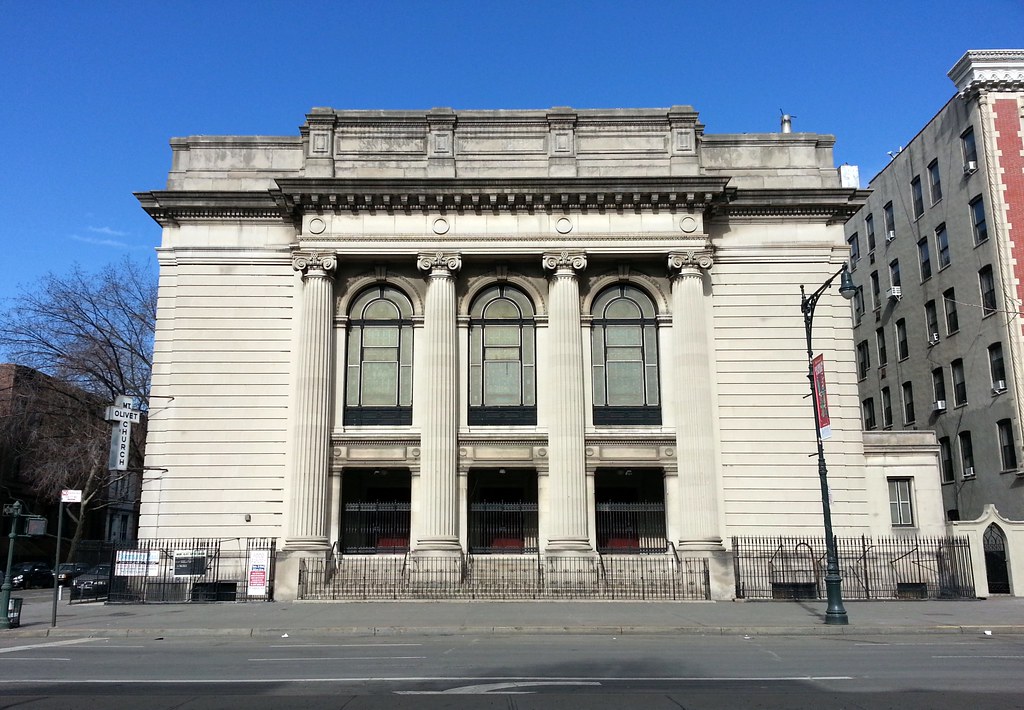
Mount Olivet Baptist Church, formerly Temple Israel, is one of many churches inhabiting old synagogues here in Harlem. There are still several visible vestiges of the building's original occupant, such as the Stars of David on the column capitals.

By far the most visible clue that the 28-acre Riverbank State Park sits atop a wastewater treatment plant
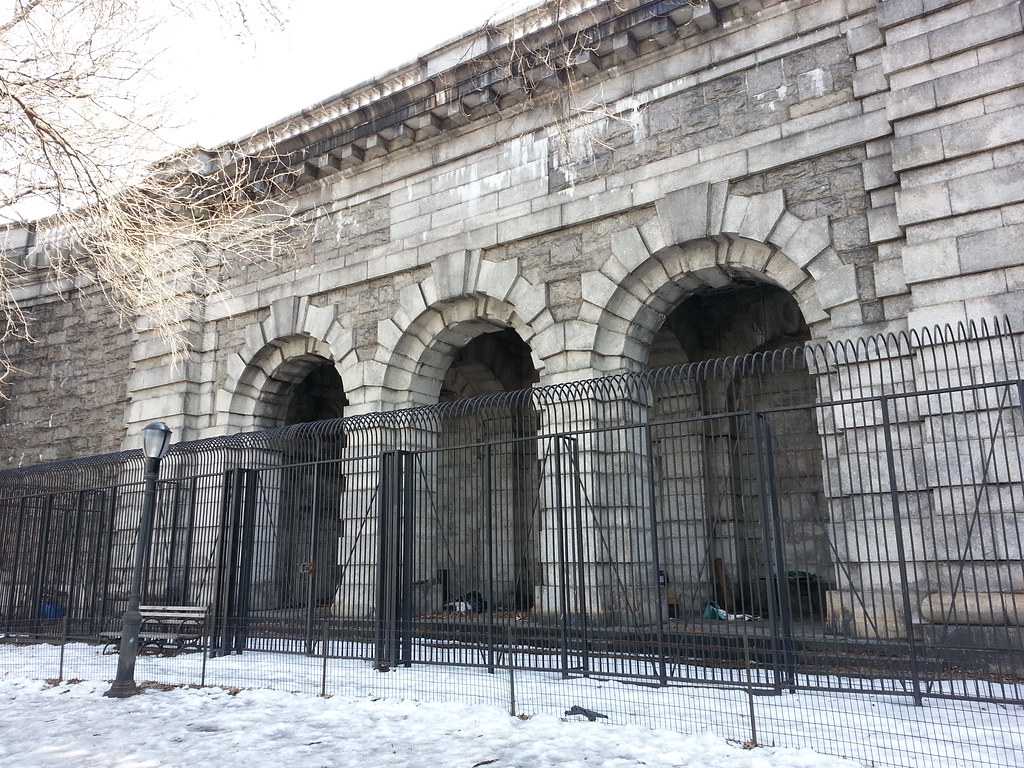
Built into the retaining wall that supports Riverside Drive, this beautiful stone arcade in Riverside Park is now off limits to the public.
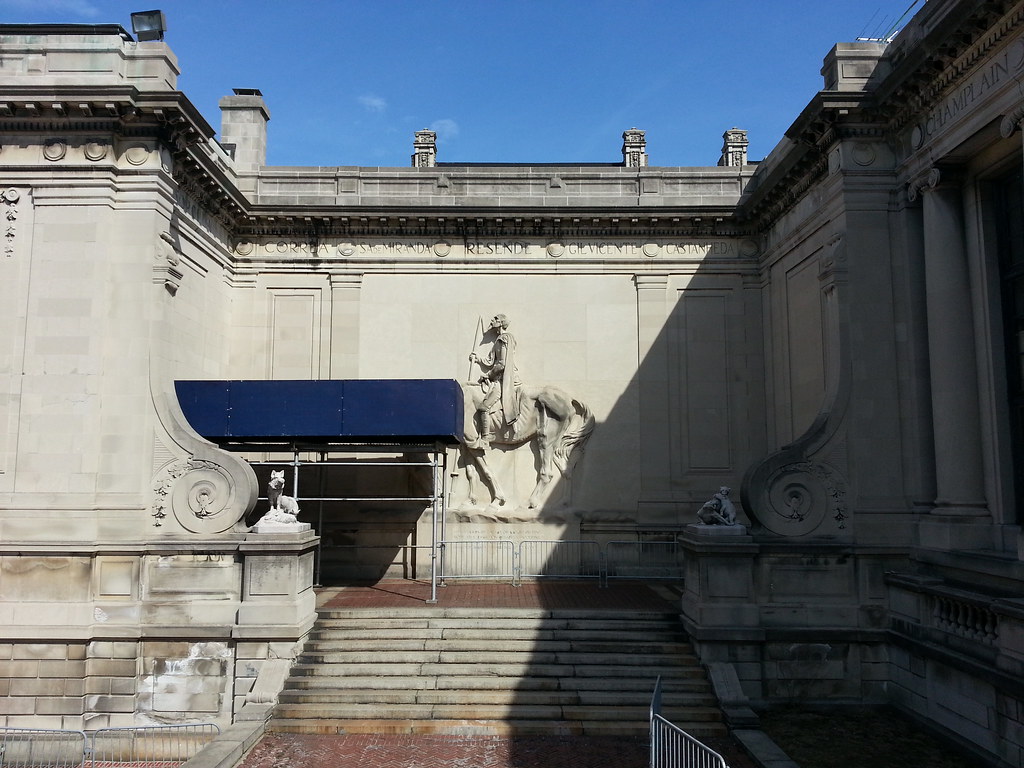
Don Quixote and his majestic steed Rocinante adorn this niche in the courtyard of Audubon Terrace, a "stupendous neo-Classical complex" of museum buildings (aerial photo here) located off Broadway at the southern edge of Washington Heights. Conceived by Archer M. Huntington, the son of Arabella Huntington (who would become "the richest woman in the world") and stepson of railroad magnate Collis P. Huntington, it was built over the first three decades of the 20th century on part of the former estate of John James Audubon (who is buried nearby in Trinity Church Cemetery). The sculpture above, along with several others in the courtyard, was created by Anna Hyatt Huntington, Archer Huntington's wife.
Formerly home to several cultural institutions, Audubon Terrace has seen its ranks dwindle over the years with the departures of the American Geographical Society (which once housed "the largest private geographical collection in the western hemisphere"), the Museum of the American Indian, and the American Numismatic Society. The Hispanic Society of America and the American Academy of Arts and Letters have held strong, however, each annexing one of the vacated buildings, and Boricua College is now an established presence on the campus as well, having moved in decades ago. (The Church of Our Lady of Esperanza is also located on Audubon Terrace, but it feels like a separate entity, facing out onto the street rather than the common courtyard.)

This heroic statue of the Spanish warrior, sculpted by Anna Hyatt Huntington, stands just to the left of Don Quixote in the courtyard of Audubon Terrace. Here's a wider shot of the magnificent scene.

The only thing I can tell you about this perplexing addition to the courtyard of Audubon Terrace is that, unlike the sculptures seen in the previous two photos, it is almost certainly not the work of Anna Hyatt Huntington.
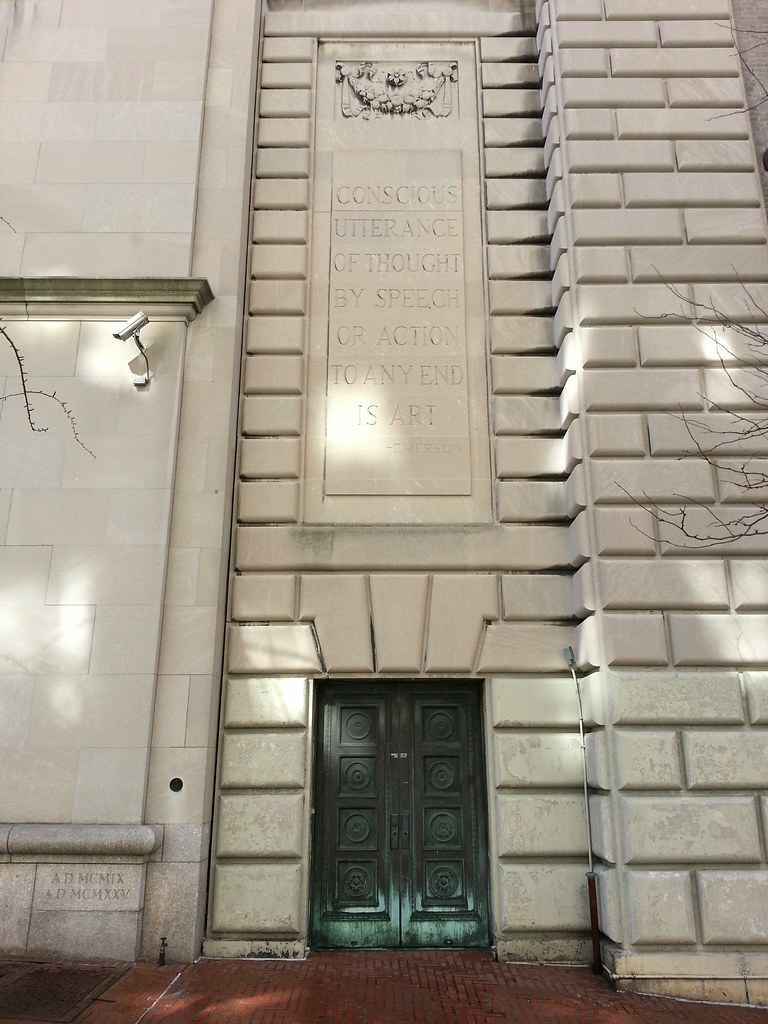
A street-level doorway on the 156th Street side of the American Academy of Arts and Letters

The George Washington Bridge, the West Side Line, and, off to the left, the Hudson River

Better known as the Little Red Lighthouse, this is the only lighthouse on the island of Manhattan* (not counting the Titanic Memorial Light). It was originally erected in Sandy Hook, New Jersey, where it stood from 1880 to 1917, and it was moved here in 1921, several years before construction began on the neighboring George Washington Bridge. The Coast Guard decommissioned the lighthouse in 1947 or 1948, but the city decided to relight it in 2002.
The lighthouse was immortalized in the pages of the 1942 children's book The Little Red Lighthouse and the Great Gray Bridge, in which the diminutive beacon comes to feel insignificant and unneeded as the massive bridge is built and lit up above it. But on one dangerously foggy night, the bridge calls out:
"Little brother, where is your light?"* There are, however, two other lighthouses in the borough of Manhattan: the Roosevelt Island Lighthouse and the Statue of Liberty, which in its early years was officially operated as a lighthouse — the first one in the US to use electric lights, in fact.
"Am I brother of yours, bridge?" wondered the lighthouse. "Your light was so bright that I thought mine was needed no more."
"I call to the airplanes," cried the bridge. "I flash to the ships of the air. But you are still master of the river. Quick, let your light shine again. Each to his own place, little brother."
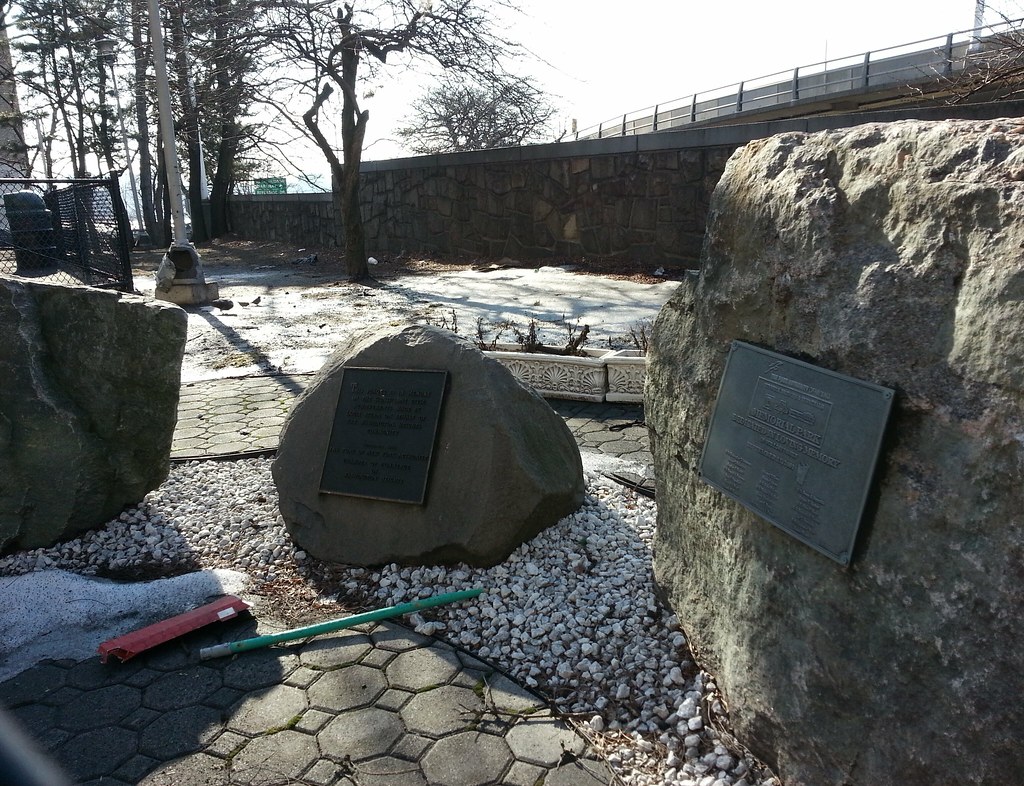
The plaque on the right reads:
THE PORT AUTHORITY OF NY & NJ
TUNNELS, BRIDGES & TERMINALS
MEMORIAL PARK
DEDICATED IN LOVING MEMORY
OF OUR LOST FAMILY
SEPTEMBER 11, 2001
and goes on to list (what I assume are) the names of the department members who were killed in the attacks.
The other two boulders bear tablets unrelated to 9/11. The one in the middle memorializes the "significant civic achievements" of Louie Stern, while the one on the left commemorates the lives lost when American Airlines Flight 587 crashed into the Rockaways two months after 9/11.

